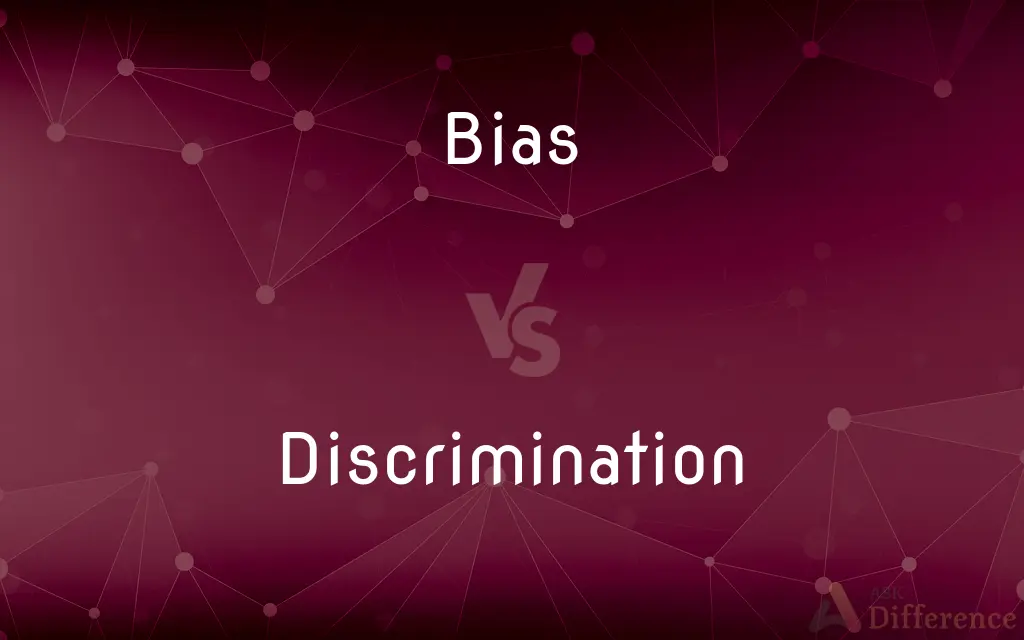Bias vs. Discrimination — What's the Difference?
By Urooj Arif & Fiza Rafique — Updated on March 11, 2024
Bias is a predisposition or inclination towards or against something or someone, often unconscious, while discrimination involves acting on bias, resulting in unfair treatment based on personal characteristics.

Difference Between Bias and Discrimination
Table of Contents
ADVERTISEMENT
Key Differences
Bias, whether conscious or unconscious, refers to the inclination or prejudice for or against individuals or groups based on personal characteristics, experiences, or societal stereotypes. It can manifest in various forms, such as cognitive biases affecting decision-making or social biases influencing perceptions of others. Discrimination, on the other hand, is the behavior or actions that result from biases, leading to unfair or prejudicial treatment of people based on characteristics such as race, age, gender, or religion.
Bias acts as the foundation upon which discrimination is built; it is the internal thought process that, when acted upon, can lead to discriminatory practices. For instance, a person may hold a bias against a certain ethnic group due to stereotypes but may not act on it. However, when this bias influences their decisions or actions, such as hiring practices, it becomes discrimination. Discrimination thus requires an element of action, whereas bias can exist as a thought or belief without external manifestation.
The impact of bias can be subtle and not always lead to overt discrimination, affecting judgments and interactions in unconscious ways. For example, confirmation bias might lead someone to unknowingly favor information that confirms their pre-existing beliefs about a group of people. Discrimination's impact, however, is more direct and tangible, often resulting in exclusion, marginalization, and the denial of rights or opportunities to those discriminated against.
Efforts to address bias and discrimination vary in approach. Educating individuals about biases and encouraging introspection can help mitigate biased thoughts and perceptions. Combatting discrimination often involves legal and policy measures to prevent and penalize unfair treatment. For example, workplace diversity training aims to reduce biases, while anti-discrimination laws are designed to curtail discriminatory actions.
Understanding the distinction between bias and discrimination is crucial for addressing their effects in society. While everyone may harbor biases as a result of human nature and societal influence, recognizing and challenging these biases can prevent them from escalating into discriminatory behavior, fostering a more inclusive and equitable environment.
ADVERTISEMENT
Comparison Chart
Definition
A predisposition or inclination towards or against something, often unconscious
Acting on biases, leading to unfair treatment based on personal characteristics
Nature
Cognitive or social inclination
Behavior or actions
Manifestation
Can be internal and not directly visible
Results in observable unfair treatment
Basis
Thoughts, beliefs, stereotypes
Actions based on biases
Impact
Affects decision-making and perceptions
Results in exclusion, marginalization, or denial of rights
Addressing
Through education and introspection
Legal and policy measures, education
Compare with Definitions
Bias
A predisposition that can influence behavior subtly.
Bias in favor of familiar technology influenced his decision against adopting new software.
Discrimination
Unfair treatment of individuals based on race, gender, age, or other traits.
Refusing to rent an apartment to someone because of their ethnicity is a form of discrimination.
Bias
An unconscious preference for or against a group, affecting judgment.
He showed a bias towards applicants from his alma mater during the hiring process.
Discrimination
Direct consequences of bias when acted upon.
Her decision not to hire a qualified candidate due to their religious beliefs was discrimination.
Bias
Personal or cultural prejudice that shapes interactions and opinions.
Cultural biases shaped her perceptions of traditional and modern art.
Discrimination
Actions or policies that result in exclusion or prejudice.
The company's policy disproportionately affected older employees, constituting age discrimination.
Bias
A cognitive tendency to process information based on pre-existing beliefs.
Her confirmation bias led her to ignore evidence that contradicted her views on climate change.
Discrimination
Behavior stemming from prejudices, leading to inequitable opportunities.
Discrimination in the workplace led to fewer promotions for women compared to men.
Bias
Socially constructed inclination affecting perceptions of individuals or groups.
Media portrayals contributed to his bias against certain political ideologies.
Discrimination
Legal or social practices that marginalize groups.
Laws that prevent certain groups from voting are examples of discrimination.
Bias
Bias is a disproportionate weight in favor of or against an idea or thing, usually in a way that is closed-minded, prejudicial, or unfair. Biases can be innate or learned.
Discrimination
Recognition and understanding of the difference between one thing and another
Discrimination between right and wrong
Young children have difficulties in making fine discriminations
Bias
A line going diagonally across the grain of fabric
Cut the cloth on the bias.
Discrimination
The selection of a signal having a required characteristic, such as frequency or amplitude, by means of a discriminator.
Bias
A preference or an inclination, especially one that inhibits impartial judgment.
Discrimination
The act of discriminating.
Bias
An unfair act or policy stemming from prejudice.
Discrimination
The ability or power to see or make fine distinctions; discernment.
Bias
A statistical sampling or testing error caused by systematically favoring some outcomes over others.
Discrimination
Treatment or consideration based on class or category, such as race or gender, rather than individual merit; partiality or prejudice.
Bias
A weight or irregularity in a ball that causes it to swerve, as in lawn bowling.
Discrimination
Discernment, the act of discriminating, discerning, distinguishing, noting or perceiving differences between things, with the intent to understand rightly and make correct decisions.
Bias
The tendency of such a ball to swerve.
Discrimination
(uncountable) The quality of being discriminating; acute discernment, especially in matters of good taste.
Bias
The fixed voltage applied to an electrode.
Discrimination
That which discriminates; a distinguishing mark, a characteristic.
Bias
Slanting or diagonal; oblique
A bias fold.
Discrimination
The act of discriminating, distinguishing, or noting and marking differences.
To make an anxious discrimination between the miracle absolute and providential.
Bias
To influence in a particular, typically unfair direction.
Discrimination
The state of being discriminated, distinguished, or set apart.
Bias
To apply a small voltage to (a grid).
Discrimination
The arbitrary imposition of unequal tariffs for substantially the same service.
A difference in rates, not based upon any corresponding difference in cost, constitutes a case of discrimination.
Bias
Inclination towards something.
Discrimination
The quality of being discriminating; faculty of nicely distinguishing; acute discernment; as, to show great discrimination in the choice of means.
Bias
The diagonal line between warp and weft in a woven fabric.
Discrimination
That which discriminates; mark of distinction.
Bias
A wedge-shaped piece of cloth taken out of a garment (such as the waist of a dress) to diminish its circumference.
Discrimination
Unfair treatment of a person or group on the basis of prejudice
Bias
(electronics) A voltage or current applied to an electronic device, such as a transistor electrode, to move its operating point to a desired part of its transfer function.
Discrimination
The cognitive process whereby two or more stimuli are distinguished
Bias
(statistics) The difference between the expectation of the sample estimator and the true population value, which reduces the representativeness of the estimator by systematically distorting it.
Bias
(sports) In the games of crown green bowls and lawn bowls: a weight added to one side of a bowl so that as it rolls, it will follow a curved rather than a straight path; the oblique line followed by such a bowl; the lopsided shape or structure of such a bowl. In lawn bowls, the curved course is caused only by the shape of the bowl. The use of weights is prohibited.
Bias
(South Korean idol fandom) A person's favourite member of a K-pop band.
Bias
(transitive) To place bias upon; to influence.
Our prejudices bias our views.
Bias
(electronics) To give a bias to.
Bias
Inclined to one side; swelled on one side.
Bias
Cut slanting or diagonally, as cloth.
Bias
In a slanting manner; crosswise; obliquely; diagonally.
To cut cloth bias
Bias
A weight on the side of the ball used in the game of bowls, or a tendency imparted to the ball, which turns it from a straight line.
Being ignorant that there is a concealed bias within the spheroid, which will . . . swerve away.
Bias
A leaning of the mind; propensity or prepossession toward an object or view, not leaving the mind indifferent; bent; inclination.
Strong love is a bias upon the thoughts.
Morality influences men's lives, and gives a bias to all their actions.
Bias
A wedge-shaped piece of cloth taken out of a garment (as the waist of a dress) to diminish its circumference.
Bias
A slant; a diagonal; as, to cut cloth on the bias.
Bias
Inclined to one side; swelled on one side.
Bias
Cut slanting or diagonally, as cloth.
Bias
In a slanting manner; crosswise; obliquely; diagonally; as, to cut cloth bias.
Bias
To incline to one side; to give a particular direction to; to influence; to prejudice; to prepossess.
Me it had not biased in the one direction, nor should it have biased any just critic in the counter direction.
Bias
A partiality that prevents objective consideration of an issue or situation
Bias
A line or cut across a fabric that is not at right angles to a side of the fabric
Bias
Influence in an unfair way;
You are biasing my choice by telling me yours
Bias
Cause to be biased
Bias
Slanting diagonally across the grain of a fabric;
A bias fold
Common Curiosities
How can discrimination be addressed in the workplace?
Discrimination can be addressed through diversity and inclusion training, implementing fair hiring practices, and adhering to anti-discrimination laws.
Is all discrimination illegal?
Not all discriminatory actions are illegal; legality depends on the jurisdiction and whether the discrimination violates specific laws or policies.
Can bias exist without leading to discrimination?
Yes, bias can exist as a thought or belief without necessarily resulting in discriminatory actions.
What role does education play in combating bias and discrimination?
Education helps by raising awareness of biases and their impacts, promoting empathy and understanding among diverse groups, and teaching strategies to mitigate prejudiced thoughts and actions.
Can biases be completely eliminated?
While it may be challenging to eliminate biases entirely, awareness, education, and conscious effort can significantly reduce their influence on thoughts and actions.
How do societal norms influence bias and discrimination?
Societal norms and stereotypes contribute to the formation of biases, which can be perpetuated through social institutions and media, leading to discrimination.
Why is it important to understand the distinction between bias and discrimination?
Understanding the distinction helps in identifying the root causes of unfair treatment and developing effective strategies to address both the internal and external aspects of prejudice.
What measures can organizations take to prevent discrimination?
Organizations can implement policies that promote equality, conduct regular training on diversity and inclusion, and establish clear procedures for reporting and addressing discrimination.
Can discrimination occur unintentionally?
Yes, discrimination can occur as a result of unconscious biases, where individuals may not be aware that their actions are discriminatory.
Can actions against discrimination impact societal norms?
Yes, effective actions against discrimination can challenge and change societal norms, leading to more inclusive and equitable communities.
What is the key difference between bias and discrimination?
The key difference is that bias refers to internal predispositions or inclinations, while discrimination involves actions based on those biases leading to unfair treatment.
How does cultural context affect perceptions of bias and discrimination?
Cultural context shapes what is considered normal or acceptable, influencing both the recognition of bias and the definition of discriminatory practices.
What is the role of legislation in combating discrimination?
Legislation plays a crucial role by setting legal standards for equal treatment, providing mechanisms for redress, and signaling societal commitment to combating discrimination.
How can individuals recognize their own biases?
Individuals can recognize their biases through self-reflection, seeking feedback from others, and engaging with perspectives different from their own.
What impact does discrimination have on individuals and society?
Discrimination can have profound psychological, economic, and social impacts on individuals, and it undermines social cohesion and equality in society.
Share Your Discovery

Previous Comparison
Belfry vs. Steeple
Next Comparison
Kingfisher vs. KookaburraAuthor Spotlight
Written by
Urooj ArifUrooj is a skilled content writer at Ask Difference, known for her exceptional ability to simplify complex topics into engaging and informative content. With a passion for research and a flair for clear, concise writing, she consistently delivers articles that resonate with our diverse audience.
Co-written by
Fiza RafiqueFiza Rafique is a skilled content writer at AskDifference.com, where she meticulously refines and enhances written pieces. Drawing from her vast editorial expertise, Fiza ensures clarity, accuracy, and precision in every article. Passionate about language, she continually seeks to elevate the quality of content for readers worldwide.














































